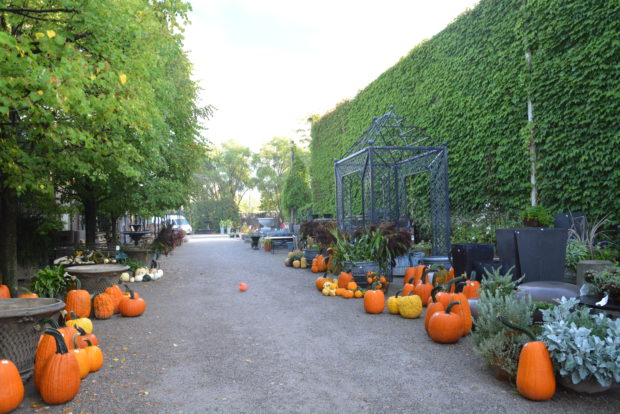 Once a year, usually when we are at our peak of fall color, I try to write about the Boston ivy that covers a neighboring 100 foot long wall parallel, opposite, and next door to Detroit Garden Works. In the early days of the shop, that originally giant cream colored concrete block wall towering over the shop made us all squint. 5 years into our tenure, we planted 10 parthenocissus tricuspidata veitchii, spaced 10 feet apart, at the base of that wall. Not so many years later, that wall was covered with a vigorous and gorgeous vine that made the trip up our driveway as green as could be. All summer long, that vine cools this corridor leading to the front door of the store. Despite the fact that watering the vines was always an afterthought, the leaves were invariably dense and glossy green. I am grateful that my lack of attention never impacts its performance. Few plants deliver as much and ask for so little as Boston Ivy.
Once a year, usually when we are at our peak of fall color, I try to write about the Boston ivy that covers a neighboring 100 foot long wall parallel, opposite, and next door to Detroit Garden Works. In the early days of the shop, that originally giant cream colored concrete block wall towering over the shop made us all squint. 5 years into our tenure, we planted 10 parthenocissus tricuspidata veitchii, spaced 10 feet apart, at the base of that wall. Not so many years later, that wall was covered with a vigorous and gorgeous vine that made the trip up our driveway as green as could be. All summer long, that vine cools this corridor leading to the front door of the store. Despite the fact that watering the vines was always an afterthought, the leaves were invariably dense and glossy green. I am grateful that my lack of attention never impacts its performance. Few plants deliver as much and ask for so little as Boston Ivy.
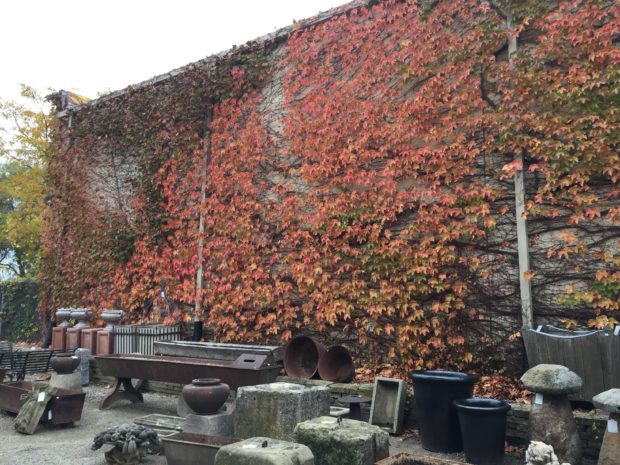 This year’s fall display is the worst for a decade. An incredibly dry summer meant the leaves on the ivy began drying up and dropping in early September. The picture above, taken today, tells the story. Large areas of this vigorous vine dropped their leaves before the cool weather arrived. An incredibly warm and lengthy late summer meant what leaves had not fallen from drought have hung on to their green color. As much as I looked forward to the spectacular fall color on this vine, nature rules the plant roost. Am I disappointed? Of course. The fall color on the Boston ivy is not just a an eagerly anticipated event, it is a happening.
This year’s fall display is the worst for a decade. An incredibly dry summer meant the leaves on the ivy began drying up and dropping in early September. The picture above, taken today, tells the story. Large areas of this vigorous vine dropped their leaves before the cool weather arrived. An incredibly warm and lengthy late summer meant what leaves had not fallen from drought have hung on to their green color. As much as I looked forward to the spectacular fall color on this vine, nature rules the plant roost. Am I disappointed? Of course. The fall color on the Boston ivy is not just a an eagerly anticipated event, it is a happening.
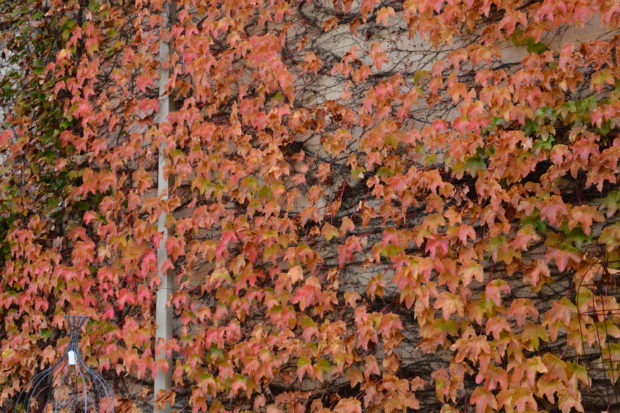 From the website Boston ivy I have copied and posted the following: “Boston Ivy is a deciduous vine with bluish fruits and bright red fall foliage. A member of the grape family, Boston Ivy is commonly used as a decorative addition for buildings. This means that it is most often used to grow on sections of buildings, walls, and fences for its aesthetic beauty. The glossy dark green leaves turn bright red in the fall. Showy leaves are held late into fall or early winter. This vine does well in poor soil and can grow in shade to full sun. While technically considered an invasive plant species (originally native to Japan), Boston Ivy’s invasive tendencies are typically shortlived, as it often succumbs to native vines (such as Virginia Creeper) when dispersed out of controlled bounds. Boston Ivy has been grown everywhere from Fenway Park in Boston to Dallas, Texas. Boston Ivy is unique in how it attaches to structures and surfaces. Unlike true ivies, such as English Ivy that attach with invasive aerial rootlets that can severely weaken brick and wood structures, Boston Ivy attaches to surfaces with tendrils tipped with sticky disks. This means that that the plant effectively glues itself to structures without structurally damaging the surface. The adhesive forces are so strong that researchers with the Plant Biomechanics Group have taken notice. Because of this special quality, Boston Ivy is not only a safe addition to structures and buildings, but a wonderful energy saving plant – effectively shading buildings during the summer and allowing buildings to absorb heat during the winter thanks to its deciduous nature.” Should you have a big wall that needs some green, consider this vine.
From the website Boston ivy I have copied and posted the following: “Boston Ivy is a deciduous vine with bluish fruits and bright red fall foliage. A member of the grape family, Boston Ivy is commonly used as a decorative addition for buildings. This means that it is most often used to grow on sections of buildings, walls, and fences for its aesthetic beauty. The glossy dark green leaves turn bright red in the fall. Showy leaves are held late into fall or early winter. This vine does well in poor soil and can grow in shade to full sun. While technically considered an invasive plant species (originally native to Japan), Boston Ivy’s invasive tendencies are typically shortlived, as it often succumbs to native vines (such as Virginia Creeper) when dispersed out of controlled bounds. Boston Ivy has been grown everywhere from Fenway Park in Boston to Dallas, Texas. Boston Ivy is unique in how it attaches to structures and surfaces. Unlike true ivies, such as English Ivy that attach with invasive aerial rootlets that can severely weaken brick and wood structures, Boston Ivy attaches to surfaces with tendrils tipped with sticky disks. This means that that the plant effectively glues itself to structures without structurally damaging the surface. The adhesive forces are so strong that researchers with the Plant Biomechanics Group have taken notice. Because of this special quality, Boston Ivy is not only a safe addition to structures and buildings, but a wonderful energy saving plant – effectively shading buildings during the summer and allowing buildings to absorb heat during the winter thanks to its deciduous nature.” Should you have a big wall that needs some green, consider this vine.
 Boston ivy asks for a big space in which to grow. It is one of the plant world’s top contenders for vigorous vertical growth in our zone. I can attest to this. No matter variations in the fall display due to weather, this vine is a beautiful in every season. The branches are beautiful dusted with snow in the winter. The emerging leaves in the spring are brilliantly colored. The large glossy leaves overlap one another, completely obscuring the wall beneath it all summer long.
Boston ivy asks for a big space in which to grow. It is one of the plant world’s top contenders for vigorous vertical growth in our zone. I can attest to this. No matter variations in the fall display due to weather, this vine is a beautiful in every season. The branches are beautiful dusted with snow in the winter. The emerging leaves in the spring are brilliantly colored. The large glossy leaves overlap one another, completely obscuring the wall beneath it all summer long.
 The view of the Boston ivy from the roof in 2016
The view of the Boston ivy from the roof in 2016
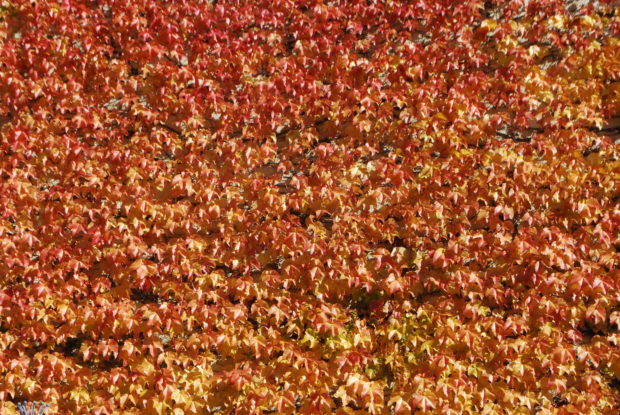 fall color on the Boston ivy 2015
fall color on the Boston ivy 2015
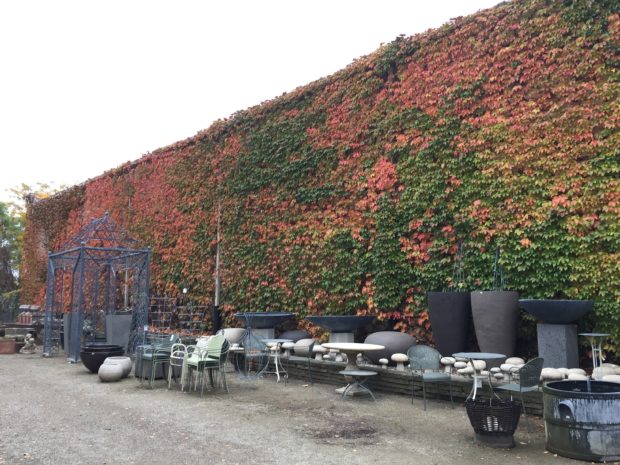 The Boston ivy at this moment is more green than fiery. I have my fingers crossed that the best is yet to come.
The Boston ivy at this moment is more green than fiery. I have my fingers crossed that the best is yet to come.
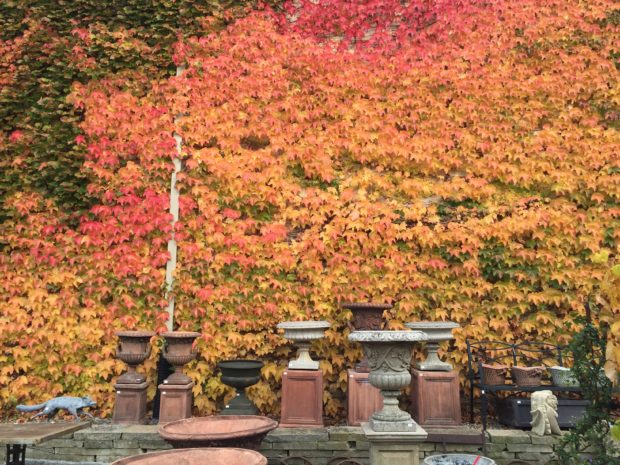
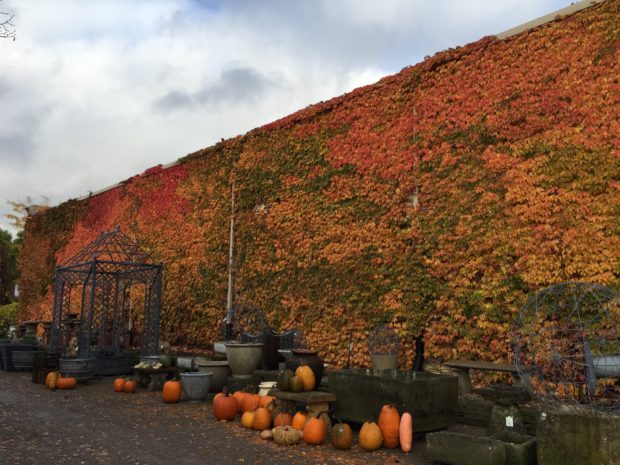
Thanks for the information about growing on walls. It definitely works well. Would you recommend it for a ground cover under a tree or would it be too hard to keep trimmed. If so, what would you recommend under a shade tree to grow vigorously?
Dear Donna, Boston ivy is born to climb. I have never seen it growing on the ground. I would look up “ground cover for dry shade on your computer” for help with growing plants under shade trees. all the best, Deborah
the ivy creates a beautiful backdrop to your fabulous planters that you sell at your shop!
Happy Halloween to you and your staff!
Boston Ivy- it must be different than our ivy. It never turns color.
We like it for ground cover but it would be nice to see some color.,
It hides of lot of spots when you are raising puppies. I recommend it over grass in that case.
Too bad you can’t throw out some seed and have ivy. A patch of ours died off last winter and it has been slow to recuperate. Appreciate not having to mow it.
Virginia
Dear Virginia, ivy is a common name that is applied to different species of plants. Boston ivy is parthenocissus. Baltic ivy, or ground cover ivy is hedera. best, Deborah
Have always loved this feature during each and every DGW visit.
Who climbs up a ladder to trim the vines at the roof line?
Dear Silvia, David trims it. best, Deborah
I would like to add the day i was there it was windy and I could not take my eyes off the Boston Ivy. It was undulating like ocean waves. Just mesmerizing! I took a video, but rarely watch it as it is still so vivid in my memory.
Barbara: Thanks for this article and pictures of your Boston Ivy covered wall. It has always been one of my favourite vines but I was always concerned about structural damage on a building. Will definitely give it a try next year.
In the past I had heard not a good idea to let ivy grow on a brick wall- as tendrils can get into and destroy the brick. Is there a difference with the Boston Ivy? WOW what a gorgeous display it makes.
Dear Carol, I specifically addressed that issue in the 3rd paragraph of the post. Boston Ivy does not damage brick or masonry like baltic ivy. The Boston Ivy covering the east coast “ivy league schools” has been on those buildings for a century or better. best, Deborah
Thank you for educating me about the different types of Ivy, I learn so much from you! I think the Ivy looks beautiful this year, just different. Whatever Mother Nature sends us is a gift, and I’m happy to see your wall this year, no matter what colors are there. Either way, it beats beige concrete blocks!
Dear Marguerite-it does indeed beat beige concrete blocks!! all the best, Deborah
Wow!
So beautiful.
So beautiful and dramatic! Your post is very interesting too Deborah. I learned a lot.
Thank you as always for your posts and pics!
Your living wall of Boston Ivy never disappoints. Spectacular. The best, full color, is yet to come!
Your previous post showing a transformation of an existing garden is wonderful. Keeping weeds out of ground cover requires regular attention. When weeds take hold the job becomes huge. Love the new boulders defining the garden.